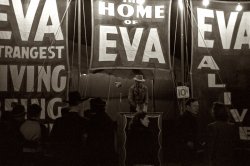
MAY CONTAIN NUTS

Search Shorpy
SHORPY ART

Framed or unframed, desk size to sofa size, printed by us in Arizona and Alabama since 2007. Explore now.
Join and Share
Ad-Free Shorpy
Shorpy is funded by you. Patreon contributors get an ad-free experience.
Learn more.

Recent comments
- Tough Guys
- Lost in Toyland
- And without gloves
- If I were a blindfolded time traveler
- Smoke Consumer Also Cooks
- Oh that stove!
- Possibly still there?
- What?!?
- $100 Reward
- Freeze Frame
- Texas Flyer wanted
- Just a Year Too Soon
- WWII -- Replacing men with women at the railroad crossing.
- Yes, Icing
- You kids drive me nuts!
- NOT An Easy Job
- I wonder
- Just add window boxes
- Icing Platform?
- Indiana Harbor Belt abides
- Freezing haze
- Corrections (for those who care)
- C&NW at Nelson
- Fallen Flags
- A dangerous job made worse
- Water Stop
- Passenger trains have right of way over freights?
- Coal
- Never ceases to amaze me.
- Still chuggin' (in model form)
Member Photos
The Shorpy
Print Emporium
Print Emporium
Search Shorpy
Search results -- 30 results per page
- Field Music: 1912
- ... two of the band are wearing their hats in the Army's new "Montana peak" style (3rd and 7th from the left) while the others have run free ... Posted by Dave - 07/04/2009 - 1:06am -
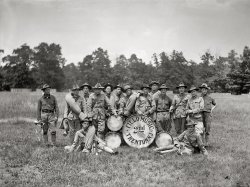
- Skill Ball: 1939
- 1939. "Night street scene in Butte, Montana." 35mm nitrate negative by Arthur Rothstein for the Resettlement ... Posted by Dave - 09/08/2010 - 12:46am -
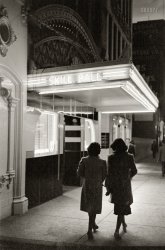
- Starting Over: 1936
- July 1936. "South Dakota drought refugees in Montana." Medium-format negative by Arthur Rothstein for the Resettlement ... Posted by Dave - 08/04/2012 - 5:10am -
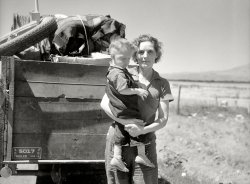
- Uneasy Rider: 1936
- July 1936. "Drought refugees from North Dakota in Montana." The lad last seen here getting a drink. 3¼ x 4¼ negative by ... Posted by Dave - 08/18/2012 - 1:52pm -
![Uneasy Rider: 1936 July 1936. "Drought refugees from North Dakota in Montana." The lad last seen here getting a drink. 3¼ x 4¼ negative by Arthur Rothstein. View full size.
Well now we knowhow he got a broken arm!
It could be worse!This series is most interesting. Thank you.
Most of us never experienced such difficult times and yet part of us know it could happen again.
[It could indeed be worse -- he could be strapped to the roof of the car. - Dave]
Come Herefor the photos, stay here for the humor! You're hilarious, Dave!
Now we know how all those kids fit in the carI was wondering where the stuff for those seven kids went, seeing as they would fill up the entire back seat of the car.
GutsyThe old saying goes that you can't tell a book by its cover but that is one onery looking little kid. If a person were able to go by looks only, I would bet you that this young man made it in life. He just looks like "intestinal fortitude" personified.
Make a trailer outta junk for nothin'!I have my copy of The Grapes of Wrath near to hand, but still can't seem to find the reference to the family who, unable to afford a car, built a trailer out of spare parts, and hitched rides by buying gas for the owner of the tow vehicle (I do recommend reading Chapter 7, a journey inside the mind of a crooked used-car salesman). Steinbeck did several years of research before publishing, and Darryl Zanuck sent private investigators out to make sure Steinbeck was telling the truth before making Grapes into a movie, so I see no reason to doubt it happened.
A kid posing on the tongue of a trailer is no reason to suppose he rode there. I can remember being fascinated by the tongue of the trailer in 1976, and there was a surplus of seats in our Chevrolet Beauville van. We had it good, I know. We still do.
I do remember my uncle some years ago recounting the days of cotton mattresses, which had to be brought out into the sun in the spring to kill the vermin. He's old enough to remember the Depression. Fortunately, our family was well-off enough that they never had to leave East Texas.
(The Gallery, Arthur Rothstein, Cars, Trucks, Buses, Dust Bowl, Kids)](https://www.shorpy.com/files/images/SHORPY_8b28049a.thumbnail.jpg)
- Special Deluxe: 1941
- September 1941. "Dude at rodeo in Ashland, Montana." Whose ponies are all under the hood. Medium format negative by Marion ... Posted by Dave - 04/23/2015 - 8:06pm -
![Special Deluxe: 1941 September 1941. "Dude at rodeo in Ashland, Montana." Whose ponies are all under the hood. Medium format negative by Marion Post Wolcott. View full size.
Tough in the HoodRemember those old cars where you could actually sit on the hood without leaving a dent?
Dude?I think she's a Dudette!
[That's "dude" in the sense of a non-cowboy of either gender dressed up in faux-cowboy fashion. Hence "dude ranches" that catered to city slickers. -tterrace]
Boots Dudette -- get those boots off my fender. Even if it is big enough to be a dance floor.
Girls on the HoodThe Good Old Days neatly defined: The people were thinner, the metal was thicker.
Paint, not so muchYes, the metal was thick and tough (which was why the car weighed 4000 lbs and had the overall agility of a dump truck) and transferred crash energy to the "crumple zone" AKA the driver and passengers!
But seeing the girl on it doesn't make me think of the metal, it makes me look at the paint. She's scratching the heck out of it. And that way some sort of lacquer, which is absurdly fragile compared to modern paint. At least it's easy to fix.
[For the record, a 1941 Chevrolet Special Deluxe weighed about 3,200 pounds. A 2015 Chevrolet Impala tips the scales at 3,800. - Dave]
Very fashionableHer jeans are made from expensive and highly sought after selvedge denim (you can tell by the seam edge where she has them turned up); common in those days - fashion buzz word in 2015.
(The Gallery, Cars, Trucks, Buses, M.P. Wolcott)](https://www.shorpy.com/files/images/SHORPY-8c31595a.thumbnail.jpg)
- Law for Tombstone: 1939
- ... cowboys."
In the early 1950s, my great-uncle, a Montana rancher, took a number of us, his grand-nieces and nephews, to see Gene ... Posted by Dave - 10/06/2012 - 12:13pm -
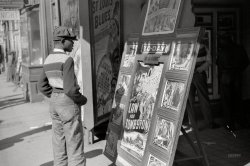
- Pat Crowe: 1921
- ... capture. He finally surrendered voluntarily in Butte, Montana. Although he admitted the crime, Crowe was acquitted on December 18, ... Posted by Dave - 08/31/2012 - 8:20pm -
![Pat Crowe: 1921 Pat Crowe, "former outlaw," in 1921. According to newspaper accounts of the day, Mr. Crowe's résumé included bank holdups, train robbery and kidnapping. National Photo Company Collection glass negative. View full size.
Pat Crowe 1859-1938Famed Bandit Dies, Aged 79
[From the Daily Mail, Hagerstown, Maryland. October 31, 1938.]
Pat Crowe, the ex-convict who lectured in Hagerstown several years ago on the theme that "Crime Doesn't Pay," died Saturday in a New York hospital, aged 79.
Crowe, once sought in a nationwide hunt as the kidnaper of Edward J. Cudahy, Jr., son of the millionaire meat packer, in Nebraska in the late nineties, was taken to the Harlem Hospital last Thursday after a heart attack in his furnished room.
A man of many aliases, Crowe was one of the most colorful figures in American criminal history. Once the object of a manhunt with a price of $50,000 on his head, he later became a reformer and preached to sideshow crowds against the evils of crime.
Jewel thief, train-robber, kidnaper and burglar, Crowe first appeared in police records under the name of Frank Roberts in Chicago, on July 5, 1890, when he was sentenced to eight years in Joliet prison for robbery.
He sprang into notoriety in the kidnaping of meatpacking heir Cudahy in Omaha just before the turn of the century. A country-wide hue and cry went up for the capture of the perpetrator of the kidnaping. Posters throughout the nation screamed a then almost unheard of reward of $50,000 for his capture.
Despite intensity of the search, Crowe eluded capture. He finally surrendered voluntarily in Butte, Montana. Although he admitted the crime, Crowe was acquitted on December 18, 1900. Crowe and his confederate, Jim Callahan, received $25,000 ransom for the return of the 16-year-old Cudahy heir unharmed.
Crowe served time in many Mid-Western prisons, including a sentence in Missouri for train robbery. In 1906, after acquittal on a robbery charge, Crowe decided to mend his ways. He gave up his life as "an enemy of society," as he dubbed himself, and only once after that was arrested for any offense. That was about nine years ago on a wintry day when, broke and hungry, he was arrested for begging. He went to jail for five days.
================================
INVESTIGATION INTO DEATH OF PAT CROWE
New York, October 31, 1938. -- Police today closed an investigation into the death of Pat Crowe, 79, old-time desperado who became an evangelist. He died Saturday in Harlem hospital, apparently of heart disease.
Detectives said a fractured skull discovered in a post-mortem examination had been incurred when Crowe toppled over a banister and fell eight feet into a hallway during a heart seizure last week.
SaddleInteresting...he appears to be on a M1904 McClellan military saddle.
SaddleGood thing I checked comments first, funny enough I was going to remark on the McClellan too. Although my guess is they were fairly common around that time as refurbished/sale items from soldiers returning from duty. Perhaps not. I rode in one during a week of cavalry demos a few years ago, not so comfy for a female pelvis.
(The Gallery, Horses, Natl Photo)](https://www.shorpy.com/files/images/05583u.thumbnail.jpg)
- Chick Magnet: 1942
- April 1942. "Hamilton, Montana. Son of Ted Barkhoefer , crawling on the kitchen floor." Acetate ... Posted by Dave - 10/23/2021 - 11:09am -
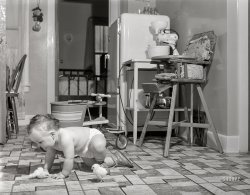
- Washstand Cowboy: 1939
- ... roller towel. Quarter Circle 'U' Ranch, Big Horn County, Montana." Photo by Arthur Rothstein for the FSA. View full size.
Pith ... Posted by Dave - 01/23/2018 - 3:18pm -
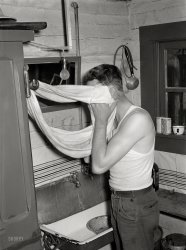
- Boundary County: 1939
- ... So named because it is bordered by Canada, Washington and Montana.
My Favorite. I think Dorothea Lange is my favorite ... Posted by Dave - 07/05/2009 - 2:14am -
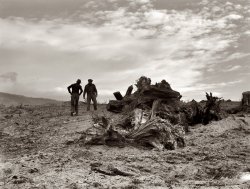
- Bat Nelson: 1911
- ... fight history to plague him. He faces a charge in Butte, Montana, of stealing the motion pictures of that fight and bringing them here. ... Posted by Dave - 08/09/2012 - 5:52am -
![Bat Nelson: 1911 Lightweight boxing champ "Bat" Nelson in 1911. After retiring from the ring, Bat (short for Battling; aka the Durable Dane, born Oscar Nielsen) dabbled in fight promotion and vaudeville. In January 1954, "a pathetic little man of 80 pounds, his mind a complete blank," Bat was committed to the Chicago State Hospital; a month later he was dead of lung cancer at age 71. With 68 wins, 19 draws and 19 losses, Bat once said that although he had "lost several fights," he had never been beaten. 8x10 glass negative, George Grantham Bain Collection. View full size.
The Durable Dane"Bat" was a real brawler, evidently. More here, including great tales and quotes.
Batty NelsonIt also proves you can only take so many hits before your mind quits. Anyone can brag all they want to about how tough they are but it gets you soon enough. How many of his 71 years were spent in a mindless state? I don't see how anyone could call boxing a sport when the goal was to knock someone senseless. If this Extreme Boxing fad that now exists goes any further we'll see even more of it.
[Bat was put under psychiatric observation in 1927 for stealing a fight film and resisting arrest. He was released after doctors at the Psychopathic Hospital found him to be not insane, just "a trifle eccentric." - Dave]
From the New York Times, 2-26-1927:
CHICAGO, Feb. 25 -- Oscar "Battling" Nelson, the famed "Durable Dane" of Hegewisch, Ill., former world lightweight champion and one of pugilism's outstanding characters, tonight is under psychopathic observation, with a charge of grand larceny hanging over him.
The Dane's greatest ring contest -- his battle seventeen years ago in which he lost the championship to Ad Wolgast -- has risen from fight history to plague him. He faces a charge in Butte, Montana, of stealing the motion pictures of that fight and bringing them here.
Nelson has developed numerous idiosyncrasies since his ring days. He often gesticulates with rights and lefts, his posture while talking often becomes a weaving, swaying motion, like a crafty ringman in battle, and he has eccentricities which, his friends say, may be traced to the terrific punishment he took while battering his way to a world title.
When officers went to Nelson's home to serve the warrant the Dane barricaded himself and surrendered only after some discussion.
When Nelson was taken into court to face extradition proceedings today, his unusual demeanor caught the attention of Judge Max Luster, who ordered him under psychopathic examination.
Battling Nelson vs Eddie LangMy great-uncle Eddie Lang fought Battling Nelson for the title in Nelson's last fight before losing his title to Ad Wolgast in about 40 brutal rounds. My grandfather (father's father) and Eddie's brother was in his corner -- he gave Nelson a scrappy fight and was KO'd in the 8th from body blows. The crowd actually cheered my great-uncle on for mixing it up and the papers called him "The Ghetto Captain." He fought the best around, and his brother Ira Lang (under the name Young Sweeney) did as well -- another great-uncle.
(The Gallery, G.G. Bain, Sports)](https://www.shorpy.com/files/images/01716u.thumbnail.jpg)
- Sleet Street: 1940
- ... full size view to the full size view of Stillwater County Montana 1942.
still broke. still broke.
[Fixed - Ken]
(The ... Posted by Dave - 12/26/2007 - 8:06am -
![Sleet Street: 1940 February 1940. A snowy street in Parkersburg, West Virginia. View full size. 35mm nitrate negative by Arthur Rothstein for the Farm Security Administration.
Wrong Full Size View LinkHi Dave. You can delete this comment once you've seen it , but you're linking the Sleet Street 1940 full size view to the full size view of Stillwater County Montana 1942.
still broke.still broke.
[Fixed - Ken]
(The Gallery, Arthur Rothstein, Cars, Trucks, Buses)](https://www.shorpy.com/files/images/8a12888u.thumbnail.jpg)
- Ghost House: 1939
- ... mine owners built substantial homes in ghost town of Pony, Montana." Medium format negative by Arthur Rothstein. View full size.
... Posted by Dave - 08/22/2018 - 11:04am -
![Ghost House: 1939 June 1939. "Gold mine owners built substantial homes in ghost town of Pony, Montana." Medium format negative by Arthur Rothstein. View full size.
Modern Day
WyethesqueThere's no Street View of Pony, but a search turns up a Wyethesque photo of this house with poppies growing in the yard, taken in June 2015:
Not a wise investmentWhy would they build homes in a ghost town?
Door to where?As curious as I am about the design for the weather vane I'm more perplexed by the door to nowhere on the second floor.
My initial thought is that they must have intended to add a porch on at some point in the future, but that wouldn't flow with the design of the home.
Having experienced challenges of moving furniture in and out of older homes more times that I would like to remember this seems like a great way to get larger items, such as the bed, upstairs without scuffing up any wallpaper.
My only other theory is that this would be a place to put the husband instead of the doghouse.
Thoughts?
[It's a tiny porch. Note the newel posts on either side of the door. - Dave]
The jigsawGod's gift to the mid-Victorian home builder.
(The Gallery, Arthur Rothstein, Mining, Small Towns)](https://www.shorpy.com/files/images/SHORPY-8b17709a1.thumbnail.jpg)
- Pony Ballet: 1925
- ...
I want to learn to rope and ride.
--Patsy Montana, "Cowboy's Sweetheart"
Cowbow Cowboy was be a history lol, just ... Posted by Dave - 09/03/2012 - 10:43am -
![Pony Ballet: 1925 December 22, 1925. Washington, D.C. "Dick Nash, Pony Ballet." (My first thought on seeing this: How did my vacation photos end up on the Internet?) 4x5 glass negative, National Photo Company Collection. View full size.
Pony BalletI want to be a cowboy's sweetheart;
I want to learn to rope and ride.
--Patsy Montana, "Cowboy's Sweetheart"
CowbowCowboy was be a history lol, just be kind ordinary person :)
[Indeed. Mamas, don't let your babies grow up to be cowbows. - Dave]
Pony BalletWould this have been at a theater? Or at some outdoor festival?
[The Pony Ballet was part of "Uncle Sam's Follies," presented at the President Theater by the D.C. Federation of Federal Employees. - Dave]
Lariat StuntsDick Nash's performance was part of a production called "Uncle Sam's Follies." He was billed as a "local Will Rogers, who did jokes and lariat stunts."
(The Gallery, D.C., Natl Photo)](https://www.shorpy.com/files/images/15337u.thumbnail.jpg)
- Stillwater County: 1942
- ... Metal Reserves chromite development in Stillwater County, Montana. View full size. 4x5 Kodachrome transparency by Russell Lee for the ... Posted by Dave - 08/05/2012 - 6:35pm -
![Stillwater County: 1942 September 1942. An early snow at the Benbow Mill of the Metal Reserves chromite development in Stillwater County, Montana. View full size. 4x5 Kodachrome transparency by Russell Lee for the Office of War Information.
Just incredibleThis site continues to blow my mind with the amazing selection of photographs ... This has made my jaw drop.
[Aw shucks. And thanks! - Dave]
(The Gallery, Kodachromes, Landscapes, Mining, Russell Lee, WW2)](https://www.shorpy.com/files/images/1a35030u.thumbnail.jpg)
- Long Distance: 1941
- ... "Telephone sign along highway. Judith Basin, Great Falls, Montana." Acetate negative by Marion Post Wolcott for the Farm Security ... Posted by Dave - 07/27/2021 - 12:37pm -
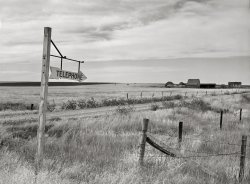
- Vista-Vision: 1939
- ... July 1939. "Cattle guard on railroad. Madison County, Montana." Photo by Arthur Rothstein for the Farm Security Administration. ... Posted by Dave - 12/17/2017 - 5:19pm -

- Black Butte: 1942
- August 1942 in Madison County, Montana. Sheep grazing the Gravelly Range at the foot of Black Butte. View ... Posted by Dave - 07/25/2012 - 6:57pm -
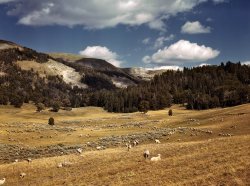
- Christmas in August: 1942
- ... Lewis and Clark National Forest, Meagher County, Montana." 4x5 Kodachrome transparency by Russell Lee for the Farm Security ... Posted by Dave - 01/15/2021 - 4:53pm -
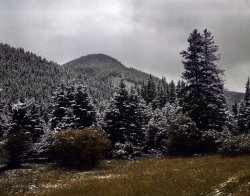
- Clack Elevator: 1941
- August 1941. "Grain storage elevators. Havre, Montana." Medium format acetate negative by Marion Post Wolcott for the Farm ... Posted by Dave - 10/11/2019 - 2:42pm -
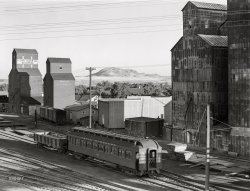
- Rosebudweiser: 1939
- June 1939. "Bartender in Birney, Rosebud County, Montana." Photo by Arthur Rothstein for the Farm Security Administration. ... Posted by Dave - 08/21/2018 - 12:23pm -
![Rosebudweiser: 1939 June 1939. "Bartender in Birney, Rosebud County, Montana." Photo by Arthur Rothstein for the Farm Security Administration. View full size.
Calendar IllustrationLooks like a Boris Artzybasheff work, can you embiggen the calendar any more? Thanks.
[The artist is Lawson Wood. - Dave]
A lemonade stand for adultsYou could not get simpler.
Sheridan Iron WorksThe business was founded in 1904 (or 1906), and the building and iconic sign were built in 1910. After first being sold in 1988, the business was sold again two years later, then was closed in 2014.
"Lucky Strike Goes to War" Lucky Strikes used to be in a green pack as they would be in this 1939 photo. When the war started the green dyes, paint and ink were redirected to the military. Luck Strike then switched to the red and white design and took out ads with the slogan, "Lucky Strike Goes to War!", I believe they were also included with the standard K-rations.
The fire extinguisher on the wall was an old brass style hand pump that had a twist lock and was filled with water. My father had one for years in our basement.
(The Gallery, Arthur Rothstein)](https://www.shorpy.com/files/images/SHORPY-8b17901a.thumbnail.jpg)
- Winter Wonderland: 1915
- ... extravaganza was designed for the Copper King of Montana by Lord, Hewlett & Hull, with a little help from the Parisian ... Posted by Dave - 04/28/2014 - 6:58pm -

- Choices: 1939
- ... June 1939. "Signs at highway intersection. Three Forks, Montana." Medium format acetate negative by Arthur Rothstein for the Farm ... Posted by Dave - 05/15/2019 - 1:51pm -
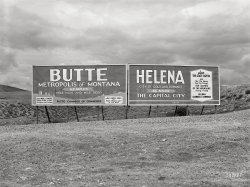
- Cleo Cola: 1941
- ... on main street of ghost town. Judith Basin County, Montana." Another look at the hamlet of Geyser, which seems to have an affinity ... Posted by Dave - 10/13/2019 - 3:01pm -
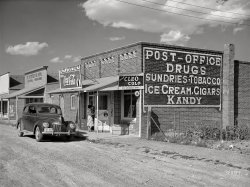
- Big Sky: 1939
- ... "Cowboy at Quarter Circle U roundup, Big Horn County, Montana." Medium format negative by Arthur Rothstein for the FSA. View full ... Posted by Dave - 02/28/2017 - 10:37pm -
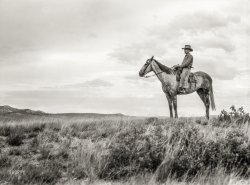
- Never Excelled: 1939
- June 1939. "Old livery stable in Virginia City, Montana." Medium format negative by Arthur Rothstein for the Farm Security ... Posted by Dave - 08/27/2018 - 9:56am -
![Never Excelled: 1939 June 1939. "Old livery stable in Virginia City, Montana." Medium format negative by Arthur Rothstein for the Farm Security Administration. View full size.
Negative SpaceA clever advertising hook is shown in that many of the adverts on the left are mimicked on the right.
The big main door is suspended from a sliding rail above, so when opened the commercial message would still show, and when closed gave a double-down.
Notice some of the bills on the right side are torn horizontally, caught by a spur on the door as it slide by.
The three no doubt fragrant piles suggest that business was still being done here.
Never Excelled But In Color
The Hyde Park beer brand was a major player in the early 1900s prior to prohibition and again after prohibition for many years. In the 1940’s they hit their zenith of sales and immediately started to lose market share to Anheuser-Busch and Griesedieck Bros breweries.
In the 1950s on their 75th year anniversary the brewery introduced Hyde Park 75 to try to secure some new market share with female drinkers, but after a few years, the brand was not a huge hit, and the brewery was sold. Shortly after the purchase the Hyde Park brand was eliminated once and for all.
Hike, Pete and Sam Siebrand owned one of the largest combined circus and carnivals in the north and southwest.
In the beginning the Siebrands were farmers and never dreamed that they soon would be in show business. More
In 1938 the co-owned Ringling Bros and Barnum & Bailey Combined Shows was experiencing labor problems which ultimately led to the circus being closed after performances in Scranton, Pennsylvania on June 22.[5] After regrouping at the circus winter quarters in Sarasota, Florida the Ringling-Barnum circus trains were dispatched to Redfield, South Dakota where the two circuses met and were combined into a yet larger circus featuring many of the major stars from Ringling-Barnum. The circus toured from July 11 until November 27, 1938 as "Al G. Barnes and Sells-Floto Circus Presenting Ringling Bros. and Barnum & Bailey Stupendous New Features. More
Wonder what is the Guinness world record for coughs in a carload?
Need A Good Horse ... Cheap?Government records indicate Johanson Livery Company of Virginia City formed on March 5, 1910 and was dissolved in 1950. The photo indicates that business may not have been booming sometime well before that year. The Siebrand Brothers Circus lasted a longer spell, from the late 19th century well into the 1960s, with their traveling show and carnival. The brothers hailed from Northwood, North Dakota. No word on whether the show wintered there.
(The Gallery, Arthur Rothstein, Frontier Life)](https://www.shorpy.com/files/images/SHORPY-8b17660a.thumbnail.jpg)
- City Ice Delivery
- ... in remote areas of northern states like Minnesota, Montana and Maine.
Collecting ice. I remember my Grandmother telling me ... Posted by kevhum - 12/27/2007 - 12:15am -
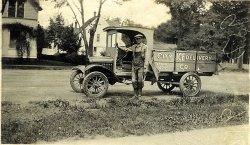
- Coca-Cola Cowgirl: 1941
- ... the rodeo at the Crow Agency Indian fair. Big Horn County, Montana." Medium format negative by Marion Post Wolcott for the Farm Security ... Posted by Dave - 02/27/2018 - 8:45pm -
![Coca-Cola Cowgirl: 1941 August 1941. "Dude from Quarter Circle U Ranch watching the rodeo at the Crow Agency Indian fair. Big Horn County, Montana." Medium format negative by Marion Post Wolcott for the Farm Security Administration. View full size.
Brand Identity is everything.
Dudette!That’s no dude. And, she appears to be sitting on the bumper of a Lincoln Zephyr. Can we get a Pretty Girls tag, pretty please?
["Dude" applied to any paying guest at the ranch; dudes of both sexes could take part in ranch work. -tterrace]
[That's no Zephyr. - Dave]
Mona Lisa smile---sitting on the front bumpber of a 1940 Lincoln Continental
---my 5th grade teacher had us design our initial monograms like the one on her shirt
[What would Teacher have to say about "bumpber"? - Dave]
(The Gallery, M.P. Wolcott)](https://www.shorpy.com/files/images/SHORPY-8c31603a.thumbnail.jpg)
- Carnival Atmosphere: 1939
- ... Summer 1939. "Amusements on the carnival midway. Bozeman, Montana." 35mm nitrate negative by Arthur Rothstein for the FSA. View full ... Posted by Dave - 09/09/2011 - 7:10pm -
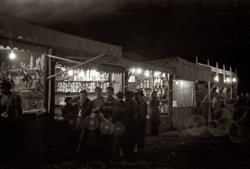
- Home of Eva: 1939
- More from the 1939 carnival in Bozeman, Montana. View full size. 35mm negative by Arthur Rothstein, who by the time ... Posted by Dave - 09/09/2011 - 11:13am -
